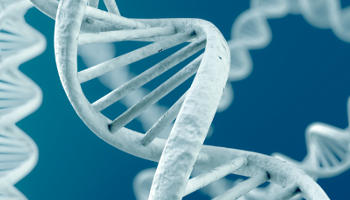From Architecture to AI-Powered Building Diagnostics: Tarek Rakha’s start-up story
10 June 2025
Published online 28 August 2015
First high-res ‘direct’ images of DNA revealed at KAUST.

© Getty Images/iStockphotoThinkstock Images
Now, Enzo Di Fabrizio's team at the King Abdullah University of Science and Technology (KAUST) has produced high-resolution direct images of a single DNA molecule.
In 2012, Di Fabrizio, then at the Italian Institute of Technology, took the first electron microscope images of DNA molecules. The power of the high-energy electron beam was too great and broke up single DNA molecules, limiting them to imaging bundles of several molecules. Now at KAUST, Di Fabrizio and his team has developed an approach using a lower beam power to take a picture of a DNA molecule.
By suspending the DNA in a holed substrate, they circumvented the electron scattering that usually occurs off a substrate. This increased the signal-to-noise ratio, reducing the electron dose required and enabling them to visualize a single DNA molecule at a resolution of 1.5 ångströms.
The team used the resultant images to measure characteristics of the DNA molecule such as its diameter and the pitch of its helix. Their measurements matched the findings of earlier X-ray microscopy experiments. Unlike conventional X-ray techniques, in which measurements are averaged over many molecules, the new method collects data from a single molecule, enabling the detection of biologically important structural variations.
The ability to make precise measurements from single DNA molecules will help researchers solve problems in structural biology and molecular medicine.
Although the final imaging step is carried out with a dry DNA molecule in a vacuum, the preparation process is designed to mimic physiological conditions. “That means during preparation we can allow the DNA to interact with proteins, for example, and undergo processes in physiological conditions,” explains Di Fabrizio.
Bart Hoogenboom, a nanoscale biophysics researcher at the London Centre for Nanotechnology who has imaged single DNA molecules with an atomic force microscope, says the work is a step forward, but highlights the need to straighten the DNA molecule during the sample preparation.
“In the living cell, DNA doesn not occur in such long straight configurations, but assumes a much more coiled and knotted structure appearance, which is important for how gene expression is promoted and repressed,” he says.
Despite this, the high-resolution images reveal important structural information that was not measured by X-diffraction, such as the length of single bases and the backbone or the helix axis tilting angle.
“Knowledge at the level of a single DNA molecule will help us understand problems related to epigenetic modifications or protein interactions,” says Di Fabrizio, adding that the new technique “can also have consequences in other field of science, such as molecular electronics and nanofabrication using DNA as scaffold.”
doi:10.1038/nmiddleeast.2015.152
Marini, M. et al. The Structure of DNA by direct imaging. Science Advances http://dx.doi.org/10.1126/sciadv.1500734 (2015)
Stay connected: